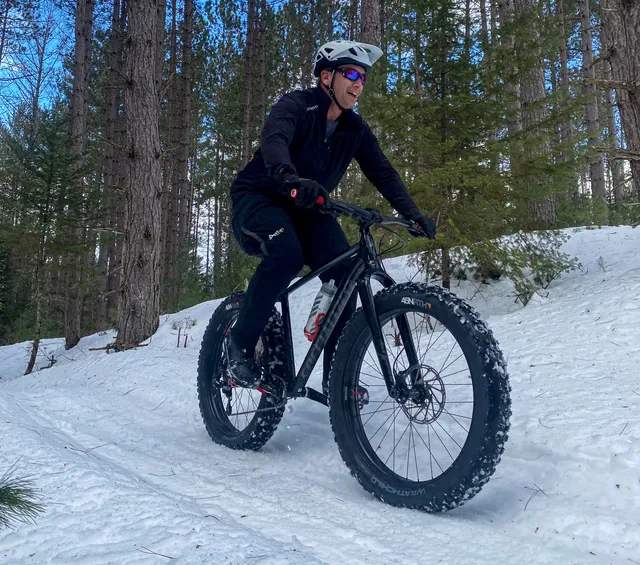Fat tire bikes offer enhanced stability and comfort, making them easier to ride on diverse terrains.
Introduction to Fat Tire Bikes
Definition and Key Features
Fat tire bikes, characterized by their oversized tires, offer a unique biking experience. These bikes typically feature tires that are 3.8 inches or wider, mounted on rims that are 2.6 inches or wider. This design significantly enhances their ability to navigate challenging terrains, such as sandy beaches, snowy paths, and muddy trails. The large surface area of the tires provides increased traction and stability, making them ideal for riders seeking a dependable ride in varied conditions. Notably, the tires can be operated at lower air pressures, ranging from 5 to 30 PSI, allowing for a smoother ride over bumps and providing a natural suspension effect.

Historical Development and Popularity
The concept of fat tire bikes originated in the late 1980s, primarily to tackle the challenges of riding on soft, unstable surfaces like snow and sand. Initially, these bikes gained popularity in off-road and adventure cycling circles. The Alaskan Iditarod trail race played a significant role in their development, with cyclists modifying their bikes to handle the demanding and varied Alaskan terrain. Over the years, advancements in materials and design have led to lighter and more efficient bikes. This evolution, combined with the versatility and unique riding experience they offer, has seen a surge in popularity among a broader spectrum of cyclists, including urban riders and those seeking a more comfortable and stable biking option. The growth in the fat tire bike market is evident, with a significant increase in options and availability, catering to a diverse range of budgets and specifications.
Comparing Riding Experiences
Fat Tire Bikes vs. Traditional Bikes
When comparing fat tire bikes with traditional bikes, several key differences stand out. Traditional bikes, such as road bikes and mountain bikes, typically have narrower tires and are designed for speed and agility on paved roads or well-maintained trails. In contrast, fat tire bikes excel in their ability to handle unstable and rough terrains with ease. The wider tires provide a larger contact area with the ground, offering enhanced grip and stability. This feature makes them particularly suitable for snowy, sandy, or muddy conditions where conventional bikes might struggle.
One notable aspect where traditional bikes outperform fat tire bikes is in speed and efficiency on smooth surfaces. Due to the larger tire surface area and increased rolling resistance, fat tire bikes require more effort to pedal, especially at higher speeds or on paved roads. However, the trade-off comes in the form of comfort and stability, as fat tire bikes absorb shocks more effectively, reducing fatigue and discomfort on uneven terrains.
Terrain Adaptability: From Sand to Snow
The adaptability of fat tire bikes to various terrains is a significant advantage. These bikes can easily navigate through sand, snow, and mud, terrains that are often challenging for traditional bikes. The low tire pressure, often between 5 to 30 PSI, allows the tires to deform over obstacles, providing a smoother ride over rocks, roots, and other rough terrain features. This adaptability makes them ideal for beach riding, snow biking, and exploring off-road trails.
In terms of cost, while fat tire bikes can be more expensive than standard mountain bikes, with prices ranging from $1,000 to over $5,000, they offer a high value for riders looking for a bike that can handle a variety of conditions. The durability of these bikes also means they can last longer, making them a worthwhile investment for avid cyclists. The weight of these bikes, however, can be a consideration for some users, as they are generally heavier than traditional bikes due to the larger frame and tire size required to support the wide tires.
Advantages of Fat Tire Bikes
Stability and Balance
One of the primary advantages of fat tire bikes is their exceptional stability and balance. This is primarily due to their wide tires, which provide a larger contact area with the ground. This increased contact area results in better grip and stability, especially on uneven or slippery surfaces. It makes them particularly suitable for beginners or those who feel less confident on a traditional bike.
| Tire Width | Typical Use | Stability Level |
|---|---|---|
| 3.8 – 4.0 inches | General Off-Road Riding | High |
| 4.0 – 4.5 inches | Snow and Sand Riding | Very High |
| 4.5 inches and above | Extreme Terrains | Extremely High |
The width of the tires plays a crucial role in determining the bike’s stability. Wider tires (4.5 inches and above) are especially beneficial for extremely challenging terrains.
Comfort and Ease of Riding
Fat tire bikes offer a higher level of comfort compared to traditional bikes. The tires can be run at much lower pressures, which allows them to absorb shocks from bumps and obstacles effectively. This natural ‘suspension’ system reduces the impact on the rider, making for a smoother and more comfortable ride.
| Tire Pressure | Terrain Type | Comfort Level |
|---|---|---|
| 5 – 10 PSI | Snow, Sand | Very High |
| 10 – 20 PSI | Rough Trails | High |
| 20 – 30 PSI | Mixed Terrain | Moderate |
Lower tire pressures (5 – 10 PSI) are ideal for snow and sand, providing maximum comfort, whereas slightly higher pressures are suitable for rough trails. The versatility in adjusting tire pressure according to the terrain type adds to the overall ease of riding.
